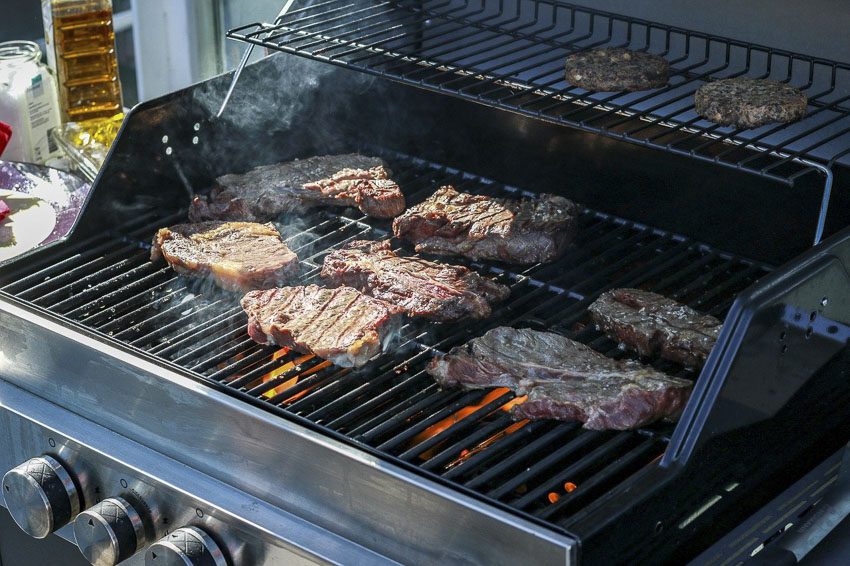Which Gas-Powered Grill Works Best for You?
We like gas grills. While a variety of options exist in the grilling world, each with its own list of pros and cons, the simplicity and versatility of a gas grill means that we don’t have to make a major production of cooking up a couple of burgers on the fly. Gas grills are easy to use and heat up quickly and evenly. They typically don’t require as much cleanup as a charcoal grill, and they don’t typically require electricity like pellet grills. But, like most things, you have a variety of options and configurations available when it comes to selecting a gas grill. So, what type of gas grill should you buy?
Pros
- Easy to use
- Reaches temperature quickly
- Lots of accessory options
- Fuel is relatively inexpensive, and it won’t expire
- Cleanup is not particularly intensive
Cons
- You’ll miss the smoky flavor of charcoal or wood
- While fuel won’t break the bank, gas grills can be expensive
Choosing Your Fuel Type
Gas grills run off of one of two main fuel types: natural gas or propane. Unfortunately, these fuels aren’t interchangeable; a propane grill will not function using natural gas, or the other way around.

Propane grills typically use standard 20-lb. propane tanks, which will run you about $20 for the initial cost of the tank and around another $20 each time you refill it. These tanks hold around 4.7 gallons of propane, which should last you around 18-20 hours of cook time using a medium-sized grill. larger grills will burn through a tank in as little as 10 hours.
Propane grills, because they run off portable tanks, are easy to wheel around to where you need them. It’s not inconceivable that you take them to the campsite or to tailgate at the big game. There are even compact models designed this particular task.
Alternatively, you could opt for a grill that runs on natural gas. Natural gas usually runs cheaper than propane, and it burns just a bit cleaner than propane (which burns really clean in its own right). Because of the nature of how the natural gas grill is powered, you won’t have to worry about ever running out of gas mid-cook.
However, this type of grill requires that you have a gas line running from your house to your grill. If you don’t, you’ll have to call your gas company to come out and install a line that runs to your grill. Not only will this require a not-insignificant upfront cost, but it means that your grill will be, more or less, a permanent fixture (meaning that you won’t really be able to transport it). Incidentally, natural gas grills are a great option if you’re looking to make a built-in showpiece grill for your patio.
Grill Size
How many people are you generally cooking for? Do you plan on cooking a variety of meats at once? Do I plan on mostly grilling at home, or will I do most of my grilling on the road? These questions are probably worth answering before you buy a gas grill.

The first thing you’ll need to figure out is how much cooking area you’ll need. This is generally expressed in terms of square inches. For instance, a three-burner grill will usually give you around 450-500 square inches of cooking area, which will accommodate enough food for four people or less.
A five- or six-burner grill might work better for someone who plans to entertain often or who has a large family to cook for. These larger grills can feature around 550-650 square inches of cooking area.
It’s also worth noting that it might be better to buy more grill than you need, rather than finding yourself in a situation where you need more grill space than you have. One of the benefits of a gas grill is that you don’t have to turn on all of the burners at once.
You might also want to cook a variety of meats at once that all require different temperature settings. Having multiple burners available is helpful here, as you can dial in different temperature settings on each burner.
Finally, if portability is a greater concern for you than size, you might find that compact gas grills work best for your needs.
Feature Sets
Once you’ve settled on your preferred fuel source and the size most appropriate for your needs, you’ll need to consider which features you want on your gas grill.
Performance Features
Some gas grills perform better than others, and that performance will often come down to their respective feature sets. Here are some of the features you ought to consider when deciding on which gas grill you should buy.
- Metal Burner Shield: By shielding the burners from falling juices, this feature reduces flare-ups and helps maintain even heat distribution.
- Ceramic briquettes line the bottom of the grill and absorb falling juices before they can cause flare-ups.
- Ceramic rods placed below the cooking grid can help maintain an even heat distribution.
- Burner and port locations: Burners set lower in the grill can ensure more even cooking, while burner ports located at the sides of the burners, rather than at the top, can reduce clogging and flare-ups.
- Limited heat output prevents the metal shroud from becoming too hot.
- Metal burner shields will help maintain even heating.
- High BTU burners located close to the cooking surface will allow you to sear meats.
- Indirect cooking: Grills with three or more burners will allow for indirect cooking for more delicate foods.
Grate Choice
You also have options when it comes to your grate. Stainless steel grates tend to be the cheapest options, and also the least durable with a tendency to chip. But, they do resist food sticking to them.

Porcelain-coated grates fall into the mid-range on prices. The coating protects the grate from rusting, and you don’t need to season it. Cleanup is simple, but you’ll want to avoid metal scrapers and these grates can ship easily too.
Cast iron grates are the heaviest and most durable choice, presenting the best choice for even heat distribution. They do, however, require a good bit of maintenance to keep them from rusting.
Accessories
We live in a golden area for grilling, particularly in terms of being able to enhance the cooking experience through convenient features. When buying a gas grill, know that you have accessory options that make outdoor grilling feel a lot more like cooking in your kitchen.
- Flat Tops: Griddles are available to turn your grated cooking surface into a flat one, making fajitas, fried rice, bacon, and eggs all possible with your gas grill.
- Rotisseries: Rotisserie cooking with your gas grill is possible with kits that include mountable motors and counterweights that turn a spit inside your grill.
- Smoker box: With a smoker box, you can have your food infused with smoky flavor as your gas grill provides the heat necessary to keep wood chips smoldering.
- Searing zones/Infrared burner: This option uses a powerful burner to quickly reach a high temperature to sear your meat, locking in juices. Once seared, you can move the meat to the main grate to finish.
- Side burners: Generally, side burners will sit off to the side of your grilling surface, running off the propane tank or gas line. This lets your prepare sauces or keep food warming without requiring you to leave the grill.
- Warming racks: These provide a raised surface away from the direct heat of the grill to keep finished meats warm.
Plenty of other options exist, from LED-lit control dials and electronic ignitions to thermostats and fuel gauges. When buying a gas grill, you won’t be short of available options; if there’s something you want, there’s likely an accessory or feature to make it happen.





